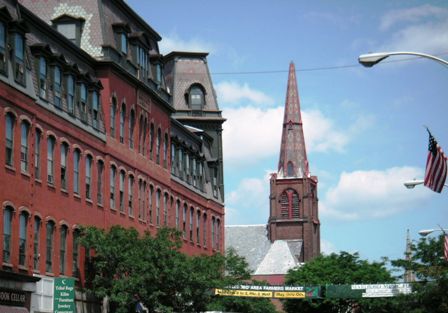|
 |

| POSC 2103 US Government (web v) |
|
political participation (ch 7)
Points to ponder:
- There are a variety of means of participating politically, sometimes called “modes of participation”
- There are what are sometimes called conventional political activities (Verba et al. 1987: 51 ff), including
- Voting
- Campaigning which is to say being active in political campaigns and party activities including such things as wearing campaign buttons, putting up yard signs on your lawn, contributing money to a candidate, distributing leaflets, etc.
- Communal activity which refers to participation in the activities of groups other than political parties such as the Chamber of Commerce, the National Organization of Women, the National Education Association, or the PTA
- Parochial contacting, which is making direct contact with government officials but only for the purpose of having getting a personal response rather than one that affects others (complaining to the Sanitation Department about poor service, not trying to get recycling program for the city; contacting your Senator because of a problem with your Social Security check, not trying to get him or her to change the Medicare prescription drug program)
- Then there are unconventional political activities--unconventional because relatively few people engage in them
- Many of the unconventional political activities are legal, just rarely undertaken—marches and boycotts are examples
- Other unconventional activities, also rarely undertaken, involve illegal acts; examples here are sit-ins and property damage
- These modes of political participation can be compared along several dimensions
- The amount of pressure they exert on government officials
- The amount of information they convey; in other words, how clear it is to others what is the objective of the act
- The scope of outcome—does a positive result only impact the political participant or does it have general application
- Whether the act clearly involves conflict with others
- How much initiative is required of the actor
- Whether the act can be accomplished by an individual alone or requires the participation of others
- How high are the costs of participation measured in terms of money, time required, the psychological effort demanded, and the level of personal exposure
- Whether the act can be carried out at any time or only at set times (for example, at election time)
- An issue separate from the modes of participation in which people engage are the levels of activity, or extent of political participation, by different individuals; not only do individuals vary in the ways they participate but they also vary considerably in how much they participate (Coleman et al. [251-53] make this point with respect ot voting but it applies to other forms of participationas well)
- Political scientists often characterize elections in terms of interest and information: for example, congressional elections are often described as low interest, low information campaigns because voters on the whole indicate that they are not terribly interested in the campaign and often are incapable of naming the candidates and are even more ignorant of the candidates’ policy stands; presidential campaigns generate relatively more interest and voters have somewhat more information, but even these are not what democratic theory might expect.
- Party identification can be defined as a psychological attachment to one political party or another
- #1: "Generally speaking, do you usually think of yourself as a
Republican, a Democrat, an Independent, or what?"
- #2
- (IF REPUBLICAN OR DEMOCRAT) "Would you call yourself a strong
(REPUBLICAN/DEMOCRAT) or a not very strong (REPUBLICAN/DEMOCRAT)?"
- (IF INDEPENDENT, OTHER [1966 and later: OR NO PREFERENCE]:) "Do you
think of yourself as closer to the Republican or Democratic party?"
- this then yields 7 different categories: strong Republican, weak Republican, Republican-leaning Independent, [pure] Independent, Democrat-leaning Independent, weak Democrat, strong Democrat (Figure 7-2, Figure 7-4)
- note that being a [pure] Independent does not mean identifying with the Independent Party but being independent, not pyschologically attached, to either the Republicans or Democrats
- An interesting pattern of partisan change applied for a long time in much of the South, including Arkansas, though the pattern appears to be way on the way out; formerly solidly Democratic (until 1972), one can see a trend that formerly "yellow dog Democrats" ["I'd vote for a yellow dog if he was a Democrat"] continued voting for Democrats in congressional elections and state and local contests but then split their tickets to vote for Republican candidates for president
- Coleman et al. do a good job of defining and explaining party identification and issues as factors in voting but don't do such a good job on candidate evaluations (261) which seek to determine how much voters like one candidate compared to another; one can measure candidate evaluations in a number of ways
- one is to use a feeling thermometer, asking respondents to place candidates on a 1 to 100 scale
- another is to ask respondents what they like about Tweedledum and what they dislike about Tweedledum, then what they like about Tweedledee and what they dislike about Tweedledee, assigning a +1 for every like and a -1 for every dislike and summing
- Sometimes it is not the paradox of voting, but the pairajacks of not voting (R.C. Archibold, "Election at a draw" NY Times 16 June 09)
Questions to consider:
- Why might it be said that having the right to vote is a necessary condition for citizens to be politically effective in communal activity and parochial contacting?
- How does the political socialization process help resolve the paradox of voting?
- While elections are clearly important, as a means by which the people can choose those who will hold government office, how much do they tell us about public policy preferences? Do public opinion surveys convey more information on ciitzen preferences?
- Compare Figures 7-9 and 7-10? How can one explain the differences in turnout rates between presidential and off-year elections (so-called because there is no presidential race in those years)?
- Why might it be that House incumbents are increasingly successful in being reelected, and what are the implications of the increase in “safe” seats?
- Turnover refers to a situation in which a seat in Congress is occupied after an election by someone different than the person who held the seat before the election. Turnover rates in the Senate have historically been higher than in the House. Why?
- How might political knowledge, political interest, political efficacy, and political participation be related to each other?
|
|
 |
|
|


